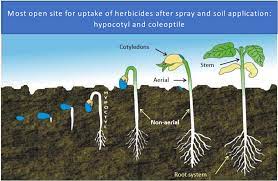Herbicides reaching the soil are subjected to various reactions with soil and environmental factors. Herbicides reach the soil through preplanting and preemergence applications, as foliage run-off from postemergence applications, and through the return of crop residues to the soil.
Interactions of a herbicide with soil and environmental factors determine its immediate phytotoxicity and subsequent degradation, and hence its persistence of activity and behaviour in the soil.
Persistence in soils is an important feature of a herbicide as it determines its suitability or otherwise in a particular soil or cropping situation.
Herbicides that decompose too readily are less desirable in some situations as they cannot be very effective on the weeds emerging later.
Conversely, herbicides with longer persistence of activity are unsuitable as their toxic residues can injure the sensitive crops grown in rotation. Thus, a herbicide which becomes more desirable in some situations may not be useful in other situations (Rao, 2011).
Herbicide Absorption Mechanisms by Soil Particles
Absorption of herbicides by soil particles occurs through a number of mechanisms involving varying bond strengths. It is dependent on the herbicide characteristics, soil surface characteristics and competing solutes.
Read Also : Management Practices Affecting the Mobility of Pesticides in Soil
The strength of adsorption affects molecule mobility along the soil profile and thus, its bioactivity, persistence, biodegradation, leaching, and the volatilization process.
The adsorption of an agrochemical onto the soil components can be considered as the first step towards its chemical degradation (Blasioli etal., 2011).
Organic molecule adsorption modeling by soils is frequently done using adsorption isotherms, which are built by measuring the residual concentrations of pollutant in aqueous solution at the equilibrium point, after the adsorption on soil of different initial concentrations.
For each concentration point, the adsorbed molecule concentrations are determined by the difference between initial and equilibrium concentrations. Adsorption data are commonly fitted using two different models described by the Langmuir and Freundlich equations (Blasioli etal., 2011).
The physicochemical mechanisms governing adsorption of herbicides by soil include hydrophobic partitioning, London-van der Waals forces, hydrogen bonding, cation and water bridging, anion exchange, ligand exchange, protonation, cation exchange and covalent bonding (Harper, 1994).

Hydrophobic partitioning
This involves partitioning of an organic chemical from the aqueous phase into the more hydrophobic organic matter. Hydrophobic partitioning is the proposed mechanism of adsorption for chemicals in the soil though it is not widely applicable for herbicides (Rao, 2011).
London-Vander Waals forces
These are short-range bonds, resulting from a correlation in electron movement between two molecules to produce a small net electrostatic attraction.
This mechanism is characterized by low heats of adsorption (20 kcal mol-1 or less) or low binding strength and short residence time on the adsorptive surface (1 × 10-2 s or less). This indicates that the strength of these bonds is weak and decreases with distance.
The interaction is additive, however, and increases with area of contact. As a result, interactions caused by London-van der Waals forces are particularly important for neutral high molecular weight compounds (Rao, 2011).
Hydrogen bonding
This involves dipole-dipole interactions involving an electrostatic attraction between an electropositive hydrogen nucleus or functional groups such as –OH and –NH and exposed electron pairs on electronegative atoms such as O– and N– electropositive atom.
These bonds are stronger than London-van der Waals forces and can be both intra- and intermolecular. Hydrogen bonding is considered to be most prevalent in the bonding of herbicides to organic surfaces in the soil.
Hydrogen bonding is a significant binding mechanism for triazines, sulfonylureas and aryloxyphenoxypropionics.
Cation and water bridgings
These involve complex formation between an exchangeable cation and an anionic or polar functional group on the herbicide. In cation bonding, the organic functional group displaces hydrating water molecules around the cation to form the complex.
Water bridging occurs when the organic functional group is unable to displace hydrating water molecules from the cation. Water bridging is more likely to occur with the larger, high valency cations such as Fe3+, Al3+ and Mg2+.
Read Also : Site Conditions Affecting the Mobility of Pesticides in Soil
Cation and water bridging are proposed mechanisms of adsorption for fluazifop-butyl, glyphosate, and picloram (Rao, 2011).
Anionbonding
This is a stronger adsorption mechanism caused by an electrostatic attraction of an anion to a positively charged site on the soil surface.
This mechanism becomes significant only in acidic soils containing a pH-dependent charge from kaolinite or amorphous aluminosilicates and iron oxides.
Anion bonding is a predominant adsorption mechanism in herbicides having dissociated functional groups such as carboxylates.
Ligand exchange
This mechanism involves displacement of an inorganic hydroxyl or water molecule from a metal ion at a hydrous oxide surface by a carboxylate or hydroxyl on an organic molecule. This is the mechanism proposed for adsorption of chlorsulfuron and possibly other sulfonylurea herbicides on iron oxides.
Protonation
In protonation, a charge-transfer complex is formed when a functional group like an amino or carboxyl group forms a complex with a surface proton.
For herbicides with basic functional groups, protonation is a significant adsorption mechanism at acidic mineral surfaces at low pH and water content. These include fluazifop, chlorsulfuron and certain triazines.
Cation exchange
This involves exchange of cations through an electrostatic attraction on the soil surface. This mechanism is predominant in herbicides which are predominantly cationic, such as paraquat and diquat.
Weakly basic herbicides with functional groups such as amines and heterocyclic N compounds may protonate to form the cationic form. Bypyridiliums, triazines and fluridone are adsorbed by the cation exchange mechanism (Rao, 2011).
Covalent bonding
This is an irreversible binding of herbicides and other metabolites to soil organic matter. It is formed by oxidative coupling and enzymatic polymerization. Covalent bonding reduces the availability and extractability of absorbed herbicides.

